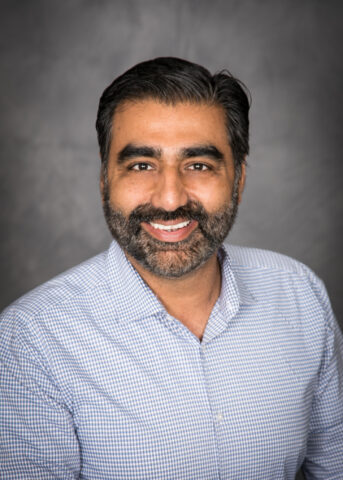In November 2021, the FDA approved Voxzogo (vosoritide) to assist with linear growth in children ages 5 and older with achondroplasia whose growth plate remained open. At the end of 2023, the FDA extended approval to children of all ages with achondroplasia with open growth plates.
Many suspect this increased candidacy will further improve care of children with achondroplasia, the most common form of dwarfism.
“We know from clinical experience and growth data from studies that every year children undergo treatment [with Voxzogo] leads to an accumulative effect on linear growth,” says Dr. Amrit Bhangoo, board-certified pediatrician, pediatric endocrinologist, director of research at Children’s Hospital of Orange County (CHOC) and associate professor of pediatrics at University of California, Irvine. “With older patients, when puberty starts growth can be limited — even with treatment.”

Starting earlier, then, signifies a large step toward helping children with achondroplasia reach their growth potential.
Positive growth outpaces study results
Not treating achondroplasia can severely affect the height of a child throughout life. Dr. Bhangoo states that the average height in untreated adult males is 131 centimeters. Untreated females reach an average height of 124 centimeters.
To begin treatment as early as possible, it is incumbent upon clinicians to identify and refer patients with features of or similar to those of achondroplasia to experts in the following disciplines:
- Genetics. A timely genetic-centric diagnosis allows therapy to begin as early as possible.
- Neurosurgery. A pediatric neurosurgeon should evaluate the patient for symptoms of spinal cord compression requiring surgical intervention.
- Sleep apnea. This is a common, potentially life-threatening complication in infants with achondroplasia. Detecting it early reduces risk.
After a child receives a diagnosis of achondroplasia, the newly updated approval permits them to begin a regimen of Voxzogo at any age. Administered daily via subcutaneous injection, Voxzogo affects linear growth by working on the growth plates of the endochondral bone — primarily long bones. In early studies, children ages 5 and older grew an average of 1.57 centimeters more in one year than their peers who received a placebo.
Exciting as these numbers are, Dr. Bhangoo has treated patients who experienced substantially more improvement.
“The growth response is better than what is documented,” he says. “Within the first year, some patients respond so well to Voxzogo that they grow as much as 7 centimeters.”
A safe new protocol
To date, Voxzogo lacks data suggesting any change in mortality and morbidity for patients. Its safety profile among children 0 to 5 years is as follows:
- More than 10% experience adverse reactions.
- Eighty-six percent of reactions were injection site reactions.
- Twenty-eight percent experienced rash.
- Some experienced a reduction in blood pressure, with good hydration and proper nutrition reducing the risk.
- Researchers posited a potential risk of worsening foramen magnum stenosis. However, available data does not support this risk.
Because of this positive safety profile, the door seems wide open for long-term use of Voxzogo without the potential for negative consequences. Knowing this provides confidence for clinicians to prescribe continual use of Voxzogo from birth until the growth plates close. On average, this leads to 15 years of growth-improving therapy.
When parents and referring physicians indicate concern about using a medication for 15 years, Dr. Bhangoo points to data showing eight years of Voxzogo without “severe adverse effects or any development of new events.” From Dr. Bhangoo’s perspective, a clinician should discontinue Voxzogo only when the pediatric patient’s growth plates close.
“Once the growth plates have closed,” Dr. Bhangoo says, “there won’t be any further increase in height.”
To keep the growth plates open as long as possible, pediatric endocrinologists prescribe aromatase inhibitors. These inhibitors are typically used to reduce breast cancer risk by preventing hormones from becoming estrogen. Because estrogen also speeds up growth plate fusion, Dr. Bhangoo uses aromatase inhibitors to do just that. In appropriate patients, he prescribes the medication for this off-label purpose for up to two years. This provides more for Voxzogo to promote additional growth.
Looking to future findings
“The goal of Voxzogo use is improved linear growth or height in patients that permits them to engage in normal, independent daily living,” Dr. Bhangoo says. “Secondary to that we also watch for an improvement in body proportion, foramen magnum widening, reduced orthopedic deformities and improved daily activities.”
Thus far, clinicians have reported each of these improvements at various times. Preliminary data indicates that earlier treatment improves proportionate growth of the extremities while reducing spinal thoracolumbar kyphosis and genu varum.
More treatment data with a larger number of patients enrolled is necessary to confirm this preliminary data, but the potential benefits look promising. There is also promise in the likelihood of more advanced therapies reaching the market soon.
“There is continual work to develop longer-acting subcutaneous formulation and other agents that can be taken orally for treatment of achondroplasia,” Dr. Bhangoo says. “As achondroplasia is a condition due to a single defect — the de novo mutation — single gene therapy could be the future.”
Until then, Dr. Bhangoo and the team of orthopedic, endocrinology, neurosurgery, genetics and sleep specialists at CHOC continue to provide leading-edge, compassionate, individualized care for this unique pediatric patient population.

CHOC Hospital was named one of the nation’s best children’s hospitals by U.S. News & World Report in its 2025-26 Best Children’s Hospitals rankings and ranked in the endocrinology specialty.




